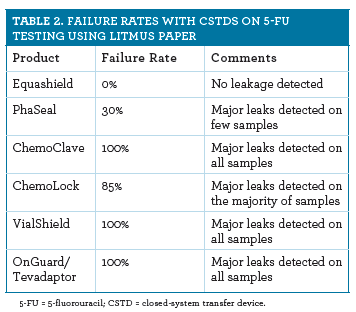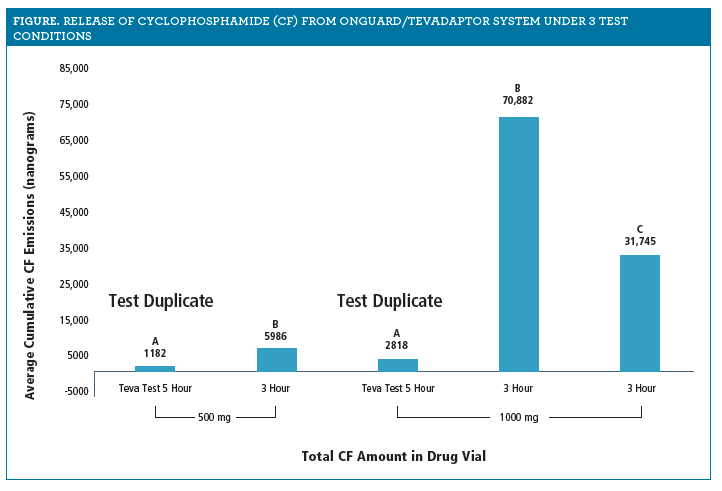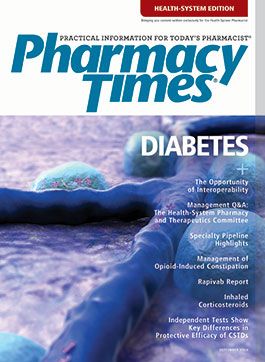Publication
Article
Pharmacy Practice in Focus: Health Systems
Independent Tests Show Key Differences in Protective Efficacy of CSTDs, with Important Implications for Pharmacists
Author(s):
A closed-system transfer device is a drug transfer device that mechanically prohibits the transfer of environmental contaminants into the system and the escape of hazardous drug or vapor concentrations outside the system.
According to the National Institute for Occupational Safety and Health (NIOSH), a closed-system transfer device (CSTD) is “a drug transfer device that mechanically prohibits the transfer of environmental contaminants into the system and the escape of hazardous drug or vapor concentrations outside the system.”
These systems have been available in the United States since 1998, and are available in different forms from several manufacturers.1,2 In addition to preventing transfer of environmental contaminants (eg, bacteria) into vials in which parenteral medications are prepared, CSTDs serve the important function of protecting health care professionals compounding and administering hazardous drugs (HD) from the occupational hazard of chronic, low-level exposure to carcinogenic and/or teratogenic medications.2
By some estimates, up to 8 million health care professionals are exposed to HDs each year. This exposure increases the risk of chromosomal abnormalities, teratogenicity, and cancer in health care workers, as documented in more than 100 studies catalogued on the CDC website.
Studies, showing the risks of handling chemotherapeutic medications, include the following:2-4
- Valanis and colleagues compared pregnancy outcomes in 2976 nurses, pharmacists, and pharmacy technicians who handled hazardous drugs, with pregnancy outcomes in 4118 women who were not health care workers. Researchers identified a statistically significant 40% greater risk of stillbirth in women handling hazardous drugs during pregnancy (odds ratio: 1.5; 95% CI: 1.2-1.9).5
- McDiarmid and colleagues identified a 9-times higher rate of structural chromosomal abnormalities (P = .04), a 24% greater risk of chromosome 5 abnormalities (P = .01), and a 20% greater risk of chromosome 5 or 7 abnormalities (P = .01) among 109 health care workers with higher exposure to antineoplastic medications versus health care workers with lower exposure to such medications.6
Occupational Safety and Health Administration (OSHA) Guidelines Recommend Use of CSTDs
In 2016, OSHA published new guidelines for the control of occupational exposure to hazardous drugs. This guideline updates a previous OSHA publication on hazardous drug handling published in 1995. Over the intervening decades since the last update, researchers identified serious hazards associated with HD handling in the workplace, and scientists developed advanced technologies to improve the safety of HD handling.7
As enumerated in the OSHA guideline, exposure to HDs may occur due to “splattering, spraying, and aerosolization” of HDs. This can occur when breaking open an ampoule, transferring medications from a drug vial, withdrawing a needle from a drug vial, expelling air from a drug-filled syringe, piercing a port or IV bag to administer an HD, as well as during many of the other processes required for HD preparation and administration.7
According to OSHA, current work practices are, in many cases, inconsistent with basic standards for HD handling. In surveys of health care workers preparing HDs, researchers found that protective gowns were not used on 20% to 36% of HD handling occasions, and gloves intended for handing chemotherapeutic drugs were not used on 8% to 10% of occasions. Similarly, for health care workers administering HDs, failure to use protective gowns was reported in 35% to 50% of cases, and failure to use specialized gloves reported on 15% to 22% of occasions.
From these data, the guidelines conclude, “These findings demonstrate that employers have failed to sufficiently protect all personnel potentially exposed to HDs.”7 Several strategies may be helpful in instituting improved HD handling practices, including developing a comprehensive hazardous drug safety and health plan, instituting drug compounding precautions, training health care workers in proper technique, and use of appropriate technologies.
CSTDs are one such technology mentioned in the OSHA guideline.7 CSTDs, which are class II medical devices, are cleared through the 510(k) process, and require evidence of substantial equivalence to an originator medical device. Although several types of CSTDs are available, it is important to note that OSHA does not consider all CSTDs equivalent in efficacy due to a lack of standard testing criteria required for FDA approval.
In the absence of a test that applies to all CSTDs, OSHA recommends that users must “carefully evaluate performance claims associated with marketed CSTDs.” Recently, with the development of a standardized protocol for testing CSTDs by NIOSH, many CSTDs can be compared using a single, standard test.7
The NIOSH Protocol
In August 2015, NIOSH published a protocol to demonstrate which CSTDs are truly effective in preventing drug vapors or liquids from escaping into the environment. This performance protocol enables unbiased comparison of CSTDs, and provides some basis for choosing a product based on its comparative efficacy with other systems. However, according to NIOSH, this protocol is not applicable to CSTDs that use an air-cleansing system (also known as filter venting systems).
Only products that are closed from the outside environment can be evaluated.8 In the past, several attempts to assess CSTDs have included the use of the inorganic tracer gas sulfur hexafluoride, lactose powder, and fluorescent compounds.
For this protocol, NIOSH settled upon 70% isopropyl alcohol (IPA) as a tracer compound due to its propensity to generate vapor at room temperature, its ubiquity, and the availability of equipment to reliably measure concentrations of IPA within a test environment using a gas analyzer (the Miran SapphIRe detector, which reports IPA concentrations in parts per million once per second).8,9
Per the NIOSH protocol, the detector continuously measures IPA concentrations in a sealed environmental test chamber (Secador Techni-dome 360 Large Vacuum Desiccator) where CSTD manipulations occur. Furthermore, the CSTD test protocol specifies testing for several types of connections made with CSTDs, including connection of the CSTD with several types of adaptors.
These may include adaptors that connect with vials, ports, Y-sites, and intravenous bags.8 IPA detectors have an important limitation: they cannot establish that zero IPA has escaped from a CSTD. But, they can establish that IPA is not present at concentrations above a lower limit of detection, below which the detector cannot reliably establish IPA levels.
For the Miran SapphIRe detector, this limit of quantification is 1 part per million—an astonishingly low concentration, equivalent to 1 teaspoon of water in a 5000-liter tank. According to NIOSH, this setup offers assurance that, “CSTD performance was as good as could possibly be measured using the particular instrument within the evaluation protocol.”8
In response to the NIOSH protocol document, Fred Massoomi, PharmD, FASHP, CSTD expert and pharmacy operations coordinator for Nebraska Methodist Hospital Pharmacy, published a series of studies available as attachments to the NIOSH protocol. These attachments include a study utilizing the NIOSH protocol to evaluate all available qualifying CSTDs on the market, a leakage test using 5-fluorouracil, and a further study evaluating filter-based (air-cleansing systems) CSTDs.9
Independent Tests: Results of CSTD Testing with the NIOSH Protocol
Researchers tested 6 systems: Equashield, PhaSeal, ChemoClave, ChemoLock, VialShield, and OnGuard/Tevadaptor. Consistent with the NIOSH protocol, researchers used the Secador Techni-Dome 360 Desiccator to contain the CSTD during manipulations of 70% IPA, and the Miran SapphIRe analyzer to detect any leakage of IPA. Throughout manipulations, 4 pharmacists and technicians continuously monitored the Miran analyzer to determine which manipulations of CSTDs led to leaks.10,11
Manipulations performed in the study included 2 tasks:11
- The first task (task 1) simulated reconstitution of a vial and preparation of an intravenous bag. Researchers first withdrew 45 mL of IPA from a vial, and injected 45-mL of IPA into a second vial, bringing the total volume of the second vial to 90-mL. Then, two 45-mL aliquots of IPA were drawn from the second vial and injected into a 500-mL 0.9% saline intravenous bag.
- The second task (task 2) simulated reconstitution of a vial and injection of the reconstituted medication into an intravenous bag at bedside. As in the first task, researchers first withdrew 45-mL of IPA from a vial, and transferred the contents to a second vial, bringing the total volume of the second vial to 90-mL of IPA. Then, two 45-mL aliquots of IPA were transferred from the second vial into the Y-site of intravenous tubing.
Of the 6 brands tested, no change in the concentration of IPA occurred for 2 systems: Equashield, and PhaSeal (Table 1). Additionally, for these 2 systems, Massoomi reported that “their testing was quick and efficient.”

In their manipulations of IPA within the testing system, no cases of failure were identified with Equashield and PhaSeal across 2 tasks. By contrast, ChemoClave and VialShield both failed with each of the 4 manipulations performed as part of both task 1 and task 2; however, ChemoLock failed in 1 manipulation performed in both task 1 and task 2.
During task 1, failure occurred during the final manipulation step (injecting the contents of vial 2 into the IV bag), and during task 2, in an earlier step (attaching the vial adaptor onto the vial).10,11 Although the NIOSH methodology is not designed to test air-cleaning systems, researchers also assessed 1 such system, the OnGuard/Tevadaptor device, to gain insight into why NIOSH excluded air-cleansing systems from the testing protocol.
With the air-cleansing system, every injection of IPA into a vial showed leakage with peak levels of IPA exceeding 10 parts per million in every case. Even after switching operators, and even when the technique was varied (ie, vials were spiked gently instead of aggressively), the OnGuard/Tevadaptor system failed to contain IPA.10,11

Independent Tests: Results of CSTD Testing with 5-Flurouracil Drug Leakage
Massoomi and colleagues tested each of 6 CSTD systems using the chemotherapeutic drug 5-fluorouracil (5-FU). Importantly, 5-FU is a basic drug, with a pH of approximately 9.2. Because 5-FU is basic, any leakage of medication will be revealed by a color change of litmus paper when a moistened piece of litmus paper is rubbed on the membranes of components that are adjacent during transfer of 5-FU.
This procedure was performed a total of 20 times for each product, with each test ruled a success (no leakage) or failure (leakage) by presence or absence of color change on the litmus paper.10,12 Major leaks were detected on all samples for ChemoClave, VialShield, and OnGuard/Tevadaptor, and with ChemoLock, the majority of samples showed major leaks. For PhaSeal, major leaks were detected in a few samples. One device, Equashield, did not show any leakage in this test, however. Failure rates are reported in Table 2.12
Independent Tests: Results of Testing for Cyclophosphamide Emission with an Air-Cleansing System (Filter Venting System)
In a study commissioned by Massoomi, and performed by American Analytics, Inc, researchers attempted to duplicate the study that was the basis for FDA’s approval under the ONB code of the OnGuard/Tevadaptor system (the ONB code is an FDA classification indicating that the system is truly closed).
In addition to duplicating this study, researchers modified the conditions of the original study to more closely represent real-world conditions.13 The OnGuard/Tevadaptor system is designed with a charcoal matrix and a 0.2 micron hydrophobic membrane intended to remove organic compounds from the system during transfer of medication.
In the original test (condition A), OnGuard/Tevadaptor was used on a cyclophosphamide vial as dry nitrogen gas flowed through the vial at a high rate of flow (300-mL/minute) for 5 hours. Transfer of medication from the vial to the adaptor occurred at a high temperature—50 degrees Celsius (122 degrees Fahrenheit).13
Three of these conditions—the lack of humidity in the dry nitrogen gas, the large volume of gas flow, and the high temperature—are firstly, not reflective of real-world conditions, and secondly, associated with ideal performance of a carbon filter. Unsurprisingly, the results of this test showed low cumulative emissions of cyclophosphamide over 5 hours (1.182 micrograms with a 500-mg vial, and 2.818 micrograms with a 1000-mg vial).13
In a modified form of the experiment (condition B), bubbles were removed before the vial was inserted into the apparatus, 4-mL of medication (with air bubbles) were injected into the vial, and 5-mL of medication were withdrawn. In a test even more representative of actual practice (condition C), 6-mL of medications were withdrawn, and 1-mL of medication was injected back into the vial to arrive at the correct dose of 5-mL.
In both conditions B and C, manipulations occurred at a lower temperature than the original condition (23 degrees Celsius, 73 degrees Fahrenheit), and over a shorter timeframe (3 hours).13
In all 3 test conditions (A, B, and C), researchers measured the amount cyclophosphamide emitted using tandem mass spectrometry. Results show release of 5 times as much cyclophosphamide under condition B versus condition A when using a 500-mL vial of cyclophosphamide, release of 25 times as much cyclophosphamide under condition B versus condition A when using a 1000-mL vial of cyclophosphamide, and release of 11 times as much cyclophosphamide under condition C versus condition A when using a 1000-mL vial of cyclophosphamide (Figure).
These results led Dr Massoomi to petition the FDA to reexamine its decision to grant an ONB code to filter-based systems.10,13

Conclusions
NIOSH performed internal tests and presented the data with the protocol, but declined to state which specific CSTDs passed the NIOSH protocol to avoid picking marketplace winners. Regardless of this decision by NIOSH, independent testing using this protocol clearly demonstrates important differences between available CSTD systems.
These results show important deficiencies in the FDA’s review processes regarding CSTDs, as data requested by the FDA led to the acceptance of several poor-performing systems granted the ONB code for CSTDs. For clinicians, the results of these independent tests should be an important consideration when choosing a system to protect health care professionals from exposure to hazardous medications.
Michael R. Page, PharmD, RPh, earned his PharmD from the Ernest Mario School of Pharmacy at Rutgers University. He has worked as a community pharmacist at CVS Pharmacy and is currently clinical editor in clinical and scientific affairs at Pharmacy Times.
References
- Centers for Disease Control and Prevention. Preventing Occupational Exposures to Antineoplastic and Other Hazardous Drugs in Health Care Settings. CDC website. http://www.cdc.gov/niosh/docs/2004-165/pdfs/2004-165.pdf. Accessed July 2016.
- Page MR. Understanding Closed-System Transfer Devices: Why They Are Important and How to Select an Appropriate System. http://www.specialtypharmacytimes.com/publications/specialty-pharmacy-times/2016/june-2016/understanding-closed-system-transfer-devices-why-they-are-important-and-how-to-select-an-appropriate-system/. Accessed July 2016.
- Gabay M. USP <800>: handling hazardous drugs. Hosp Pharm. 2014;49(9):811-812. doi: 10.1310/hpj4909-811.
- Centers for Disease Control and Prevention. Occupational exposure to antineoplastic agents and other hazardous drugs. CDC website. www.cdc.gov/niosh/topics/antineoplastic/pubs.html. Accessed July 2016.
- Valanis B, Vollmer WM, Steele P. Occupational exposure to antineoplastic agents: self-reported miscarriages and stillbirths among nurses and pharmacists. J Occup Environ Med. 1999;41(8):632-638.
- McDiarmid MA, Oliver MS, Roth TS, Rogers B, Escalante C. Chromosome 5 and 7 abnormalities in oncology personnel handling anticancer drugs. J Occup Environ Med. 2010;52(10):1028-1034. doi: 10.1097/JOM.0b013e3181f73ae6.
- United States Department of Labor: Occupational Safety & Health Administration. Controlling Occupational Exposure to Hazardous Drugs. OSHA website. https://www.osha.gov/SLTC/hazardousdrugs/controlling_occex_hazardousdrugs.html. Accessed July 2016.
- NIOSH. A Vapor Containment Performance Protocol for Closed System Transfer Devices Used During Pharmacy Compounding and Administration of Hazardous Drugs. CDC website. http://www.cdc.gov/niosh/docket/review/docket288/default.html. Accessed July 2016.
- Massoomi F. Assessing Vial Transfer Devices for Handling Hazardous Drugs. http://www.pppmag.com/article_print.php?articleid=515. Accessed July 2016.
- Massoomi F. Fred Massoomi Response to Docket No CDC-2015-0075 NIOSH 288. https://www.regulations.gov/document?D=CDC-2015-0075-0027. Accessed July 2016.
- Massoomi F. Attachment 2 Report on NIOSH's Vapor Containment Performance Protocol from CSTDs. https://www.regulations.gov/document?D=CDC-2015-0075-0027. Accessed July 2016.
- Massoomi F. Attachment 3 Report on 5-FU leakage study. https://www.regulations.gov/document?D=CDC-2015-0075-0027. Accessed July 2016.
- Massoomi F. Attachment 2 Report on NIOSH's Vapor Containment Performance Protocol from CSTDs. https://www.regulations.gov/document?D=CDC-2015-0075-0027. Accessed July 2016.







